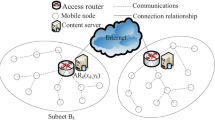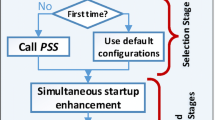Abstract
In the emerging Internet of Things (IOT), as a means to fulfill item-level lookup, lookup service or discovery service plays a critical role. However, existing lookup service and discovery service of IOT mainly rely on a centralized or a chain-style framework, thus have some drawbacks or bottlenecks to prevent them from being widely adopted, while the issue of locating hot-point resource has received much less attention, as well as the item-level lookup service is still missing. Therefore, we present object discovery service architecture (ODSA), a distributed serial number level object discovery service architecture using Chord for the IOT, give its two kinds of framework and some relevant mechanisms, and mainly focus on the Double-Ring architecture for enhancing the lookup efficiency and relieving the congestion of network by balancing the flows of query. Additionally, we analyze theoretically the node number constraint relationship between inside ring and outside ring. We conduct a simulation study based on P2PSim of MIT and our prototype to validate and evaluate the analysis and our solution. Results from the simulation validate the correctness of the theoretical analysis and the availability, scalability of our solution. The related comparisons and analysis show that our solution is available and outperforms substantially other approaches of current IOT lookup service.















Similar content being viewed by others
References
GS1. (2013). The GS1 EPCglobal Architecture Framework-Version 1.5. March 23, 2013.
GS1. (2013). GS1 Object Name Service (ONS) 2.0.1. Ratified Standard, January 31, 2013.
AT4 Wireless, BT Research, SAP Research. (2007). High level design for discovery services. BRIDGE project. University of Cambridge.
Afilias. (2008). Afilias discovery services: Enabling secure, selective visibility in global supply chains. White paper. http://www.afilias.info/webfm send/37.
Rezafard, A. (2008). Extensible supply-chain discovery service problem statement. IETF Internet-draft. http://tools.ietf.org/html/draft-rezafard-esds-problem-statement-03.
AT4 Wireless, BT Research, SAP Research. (2008). BRIDGE WP02-working prototype of serial-level lookup service. BRIDGE project. University of Cambridge.
Huang, D., Verma, M., Ramachandran, A., & Zhou, Z. (2007). A distributed ePedigree architecture. In Proceeding of the 11th IEEE international workshop on future trends of distributed computing systems, (pp. 220–230).
Stoica, I., Morris, R., Karger, D., Kaashoek, M. F., & Balakrishnan, H. (2001). Chord: A scalable peer-to-peer lookup service for internet applications. In Proceeding of the 2001 SIGCOMM conference on applications, technologies, architectures, and protocols for computer communications, ACM (pp. 149–160).
Evdokimov, S., Fabian, B., Kunz, S., & Schoenemann, N. (2010). Comparison of discovery service architectures for the internet of things. In Proceeding of IEEE international conference on sensor networks, ubiquitous, and trustworthy computing (pp. 237–244).
Ramasubramanian, V., & Sirer, E. G. (2004). The design and implementation of a next generation name service for the internet. In Proceedings of the 2004 conference on applications, technologies, architectures, and protocols for computer communications (SIGCOMM’04) (pp. 331–342).
Fabian, B., & Gunther, O. (2007). Distributed ONS and its impact on privacy. In Proceeding of IEEE international conference on communications (pp. 1223–1228).
Cantero, J.J., Guijarro, M.A., Arrebola, G., Garcia, E., Banos, J., Harrison, M., & Kelepouris, T. (2008). Traceability applications based on discovery services. In Proceeding of the 2008 IEEE international conference on emerging technologies and factory automation (pp. 1332–1337).
Manzanares-Lopez, P., Munoz-Gea, J. P., Malgosa-Sanahuja, J., & Sanchez-Aarnoutse, J. C. (2011). An efficient distributed discovery service for EPCglobal network in nested package scenarios. Journal of Network and Computer Applications, 34(3), 925–937.
Androutsellis-Theotokis, S., & Spinellis, D. (2004). A survey of peer-to-peer content distribution technologies. ACM, Computing Surveys(CSUR), 36(4), 335–371.
Klinberg, T., & Manfredi, R. (2002). Gnutella 0.6. http://rfc-gnutella.sourceforge.net/src/rfc-0_6-draft.txt.
Rowstron, A., & Druschel, P. (2001). Pastry: Scalable, distributed object location and routing for large-scale Peer-to-peer systems. Lecture Notes in Computer Science, 2218, 329–350.
Maymounkov, P., & Mazieres, D. (2002). Kademlia: A peer-to-peer information system based on the XOR metric. Lecture Notes in Computer Science, 2429, 53–65.
Jennings, C., Lowekamp, B., Rescorla, E., Baset, S. A., & Schulzrinne, H. (2009). Resource location and discovery (RELOAD). http://draft-ietf-p2psip-reload-00.txt.
Schmidt, L., Mitton, N., Simplot-Ryl, D., Dagher, R., & Quilez, R. (2011). DHT-based distributed ALE engine in RFID Middleware. In Proceedings of the 2011 IEEE International Conference on RFID-Technologies and Applications (RFID-TA) (pp. 319–329).
Cuevas, R., Uruena, M., & Banchs, A. (2009). Routing fairness in Chord: Analysis and enhancement. In Proceedings of the IEEE INFOCOM 2009 (pp. 1449–1457).
Forestiero, A., Leonardi, E., Mastroianni, C., & Meo, M. (2010). Self-Chord: A bio-inspired P2P framework for self-organizing distributed systems. IEEE/ACM Transactions on Networking, 18(5), 1651–1664.
Taylor, I. J. (2004). From P2P to web services and grids: Peers in a client/server world. New York: Springer.
Iamnitchi, A., Foster, I., Weglarz, J., Nabrzyski, J., Schopf, J., & Stroinski, M. (2003). A peer-to-peer approach to resource location in grid environments. In Grid resource management. Norwell, MA: Kluwer.
Auto-ID Center. Auto-ID Savant Specification 1.0[EB/OL].
EPCglobal. (2007). EPC Information Service (EPCIS) version 1.0.1. September.
Karger, D. R., & Ruhl, M. (2006). Simple efficient load-balancing algorithms for peer-to-peer systems. Theory of Computing Systems, 39(6), 787–804.
Muller, J., Oberst, J., Wehrmeyer, S., Witt, J., Zeier, A., & Plattner, H. (2010). An aggregating discovery service for the EPCglobal network. In Proceeding of the 2010 43rd Hawaii international conference on system sciences (pp. 1–9).
Ech-Cherif El Kettani, M. D., & En-Nasry, B. (2011). MIDM: an open architecture for mobile identity management. Journal of Convergence, 2(2), 25–32.
Elmisery, A. M., & Botvich, D. (2011). Enhanced middleware for collaborative privacy in IPTV recommender services. Journal of Convergence, 2(2), 33–42.
Aikebaier, A., Enokido, T., & Takizawa, M. (2011). Trustworthy group making algorithm in distributed systems. Human-Centric Computing and Information Sciences, 1(1), 1–15.
Bringer, J., & Chabanne, H. (2012). Embedding edit distance to enable private keyword search. Human-Centric Computing and Information Sciences, 2(1) 1–12.
Barchetti, U., Bucciero, A., DE Blasi, M., Mainetti, L, & Patrono, L. (2009). Implementation and testing of an EPCglobal-aware discovery service for item-level traceability. In Proceedings of the 2009 ICUMT conference on modern ultra telecommunication (pp. 1–8).
Floerkemeier, C., Roduner, c, & Lampe, M. (2007). RFID application development with the accada middleware platform. IEEE Systems Journal, 1(2), 82–94.
Author information
Authors and Affiliations
Corresponding author
Rights and permissions
About this article
Cite this article
Xu, DG., Qin, LH., Park, JH. et al. ODSA: Chord-Based Object Discovery Service Architecture for the Internet of Things. Wireless Pers Commun 73, 1455–1476 (2013). https://doi.org/10.1007/s11277-013-1260-3
Published:
Issue Date:
DOI: https://doi.org/10.1007/s11277-013-1260-3




